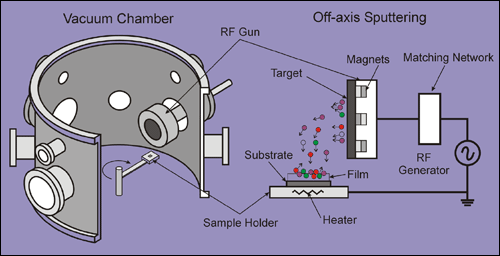In its simplest representation, the phenomenon of sputtering consists of material erosion from a target on an atomic scale, and the formation of a thin layer of the extracted material on a suitable substrate. The process is initiated in a glow discharge produced in a vacuum chamber under pressure-controlled gas flow. Target erosion occurs due to energetic particle bombardment by either reactive or non-reactive ions produced in the discharge.
 |
|
Schematic of the deposition chamber and of the off-axis RF magnetron sputtering technique
|
The off-axis radio frequency magnetron sputtering technique, schematically shown above, consists of a target, which is a plate of a stoichiometric mixture of the material to grow, and of a substrate placed on a grounded sample holder positioned at 90° of the target off-axis configuration. The glow discharge is initiated by applying power to the target in a controlled gas atmosphere, and is constituted of a partially ionized gas of ions, electrons, and neutral species. The ejected material diffuses until it reaches and nucleates on the substrate. The duration of this process controls the thin film thickness. The crystalline growth of thin films on single crystal substrates, with a well defined orientation, defines epitaxy.
The use of a radio frequency (RF) generator is essential to maintain the discharge and to avoid charge build-up when sputtering insulating materials such as PZT. The presence of a matching network between the rf generator and the target is necessary in order to optimize the power dissipation in the discharge. Magnets are used to enhanced the sputtering rate, by increasing the ionizing effect of electrons magnetically trapped in the vicinity of the target (magnetron sputtering). Their use provides the advantage of trapping not only electrons, but also charged species at the target, so that they do not hit the substrate, with an improvement of the film quality.